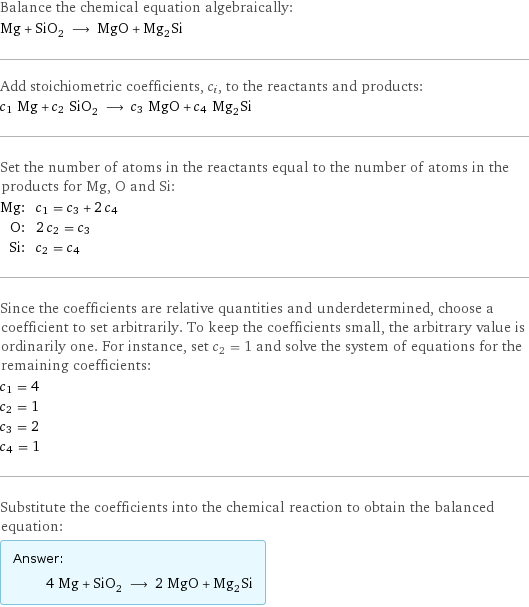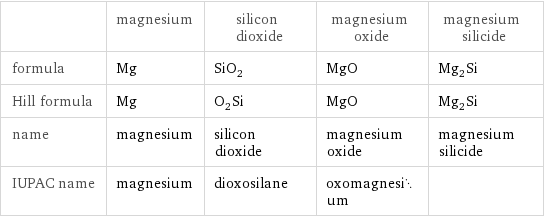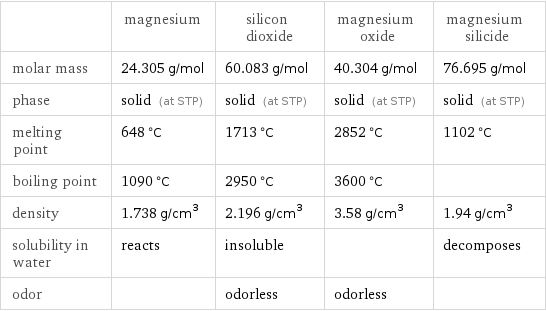Input interpretation

Mg magnesium + SiO_2 silicon dioxide ⟶ MgO magnesium oxide + Mg_2Si magnesium silicide
Balanced equation

Balance the chemical equation algebraically: Mg + SiO_2 ⟶ MgO + Mg_2Si Add stoichiometric coefficients, c_i, to the reactants and products: c_1 Mg + c_2 SiO_2 ⟶ c_3 MgO + c_4 Mg_2Si Set the number of atoms in the reactants equal to the number of atoms in the products for Mg, O and Si: Mg: | c_1 = c_3 + 2 c_4 O: | 2 c_2 = c_3 Si: | c_2 = c_4 Since the coefficients are relative quantities and underdetermined, choose a coefficient to set arbitrarily. To keep the coefficients small, the arbitrary value is ordinarily one. For instance, set c_2 = 1 and solve the system of equations for the remaining coefficients: c_1 = 4 c_2 = 1 c_3 = 2 c_4 = 1 Substitute the coefficients into the chemical reaction to obtain the balanced equation: Answer: | | 4 Mg + SiO_2 ⟶ 2 MgO + Mg_2Si
Structures

+ ⟶ +
Names

magnesium + silicon dioxide ⟶ magnesium oxide + magnesium silicide
Equilibrium constant
![Construct the equilibrium constant, K, expression for: Mg + SiO_2 ⟶ MgO + Mg_2Si Plan: • Balance the chemical equation. • Determine the stoichiometric numbers. • Assemble the activity expression for each chemical species. • Use the activity expressions to build the equilibrium constant expression. Write the balanced chemical equation: 4 Mg + SiO_2 ⟶ 2 MgO + Mg_2Si Assign stoichiometric numbers, ν_i, using the stoichiometric coefficients, c_i, from the balanced chemical equation in the following manner: ν_i = -c_i for reactants and ν_i = c_i for products: chemical species | c_i | ν_i Mg | 4 | -4 SiO_2 | 1 | -1 MgO | 2 | 2 Mg_2Si | 1 | 1 Assemble the activity expressions accounting for the state of matter and ν_i: chemical species | c_i | ν_i | activity expression Mg | 4 | -4 | ([Mg])^(-4) SiO_2 | 1 | -1 | ([SiO2])^(-1) MgO | 2 | 2 | ([MgO])^2 Mg_2Si | 1 | 1 | [Mg2Si] The equilibrium constant symbol in the concentration basis is: K_c Mulitply the activity expressions to arrive at the K_c expression: Answer: | | K_c = ([Mg])^(-4) ([SiO2])^(-1) ([MgO])^2 [Mg2Si] = (([MgO])^2 [Mg2Si])/(([Mg])^4 [SiO2])](../image_source/a135e065fe7c4d08d3a6eaaa0f179e72.png)
Construct the equilibrium constant, K, expression for: Mg + SiO_2 ⟶ MgO + Mg_2Si Plan: • Balance the chemical equation. • Determine the stoichiometric numbers. • Assemble the activity expression for each chemical species. • Use the activity expressions to build the equilibrium constant expression. Write the balanced chemical equation: 4 Mg + SiO_2 ⟶ 2 MgO + Mg_2Si Assign stoichiometric numbers, ν_i, using the stoichiometric coefficients, c_i, from the balanced chemical equation in the following manner: ν_i = -c_i for reactants and ν_i = c_i for products: chemical species | c_i | ν_i Mg | 4 | -4 SiO_2 | 1 | -1 MgO | 2 | 2 Mg_2Si | 1 | 1 Assemble the activity expressions accounting for the state of matter and ν_i: chemical species | c_i | ν_i | activity expression Mg | 4 | -4 | ([Mg])^(-4) SiO_2 | 1 | -1 | ([SiO2])^(-1) MgO | 2 | 2 | ([MgO])^2 Mg_2Si | 1 | 1 | [Mg2Si] The equilibrium constant symbol in the concentration basis is: K_c Mulitply the activity expressions to arrive at the K_c expression: Answer: | | K_c = ([Mg])^(-4) ([SiO2])^(-1) ([MgO])^2 [Mg2Si] = (([MgO])^2 [Mg2Si])/(([Mg])^4 [SiO2])
Rate of reaction
![Construct the rate of reaction expression for: Mg + SiO_2 ⟶ MgO + Mg_2Si Plan: • Balance the chemical equation. • Determine the stoichiometric numbers. • Assemble the rate term for each chemical species. • Write the rate of reaction expression. Write the balanced chemical equation: 4 Mg + SiO_2 ⟶ 2 MgO + Mg_2Si Assign stoichiometric numbers, ν_i, using the stoichiometric coefficients, c_i, from the balanced chemical equation in the following manner: ν_i = -c_i for reactants and ν_i = c_i for products: chemical species | c_i | ν_i Mg | 4 | -4 SiO_2 | 1 | -1 MgO | 2 | 2 Mg_2Si | 1 | 1 The rate term for each chemical species, B_i, is 1/ν_i(Δ[B_i])/(Δt) where [B_i] is the amount concentration and t is time: chemical species | c_i | ν_i | rate term Mg | 4 | -4 | -1/4 (Δ[Mg])/(Δt) SiO_2 | 1 | -1 | -(Δ[SiO2])/(Δt) MgO | 2 | 2 | 1/2 (Δ[MgO])/(Δt) Mg_2Si | 1 | 1 | (Δ[Mg2Si])/(Δt) (for infinitesimal rate of change, replace Δ with d) Set the rate terms equal to each other to arrive at the rate expression: Answer: | | rate = -1/4 (Δ[Mg])/(Δt) = -(Δ[SiO2])/(Δt) = 1/2 (Δ[MgO])/(Δt) = (Δ[Mg2Si])/(Δt) (assuming constant volume and no accumulation of intermediates or side products)](../image_source/1282a590a0c5e166f496700e8669ba98.png)
Construct the rate of reaction expression for: Mg + SiO_2 ⟶ MgO + Mg_2Si Plan: • Balance the chemical equation. • Determine the stoichiometric numbers. • Assemble the rate term for each chemical species. • Write the rate of reaction expression. Write the balanced chemical equation: 4 Mg + SiO_2 ⟶ 2 MgO + Mg_2Si Assign stoichiometric numbers, ν_i, using the stoichiometric coefficients, c_i, from the balanced chemical equation in the following manner: ν_i = -c_i for reactants and ν_i = c_i for products: chemical species | c_i | ν_i Mg | 4 | -4 SiO_2 | 1 | -1 MgO | 2 | 2 Mg_2Si | 1 | 1 The rate term for each chemical species, B_i, is 1/ν_i(Δ[B_i])/(Δt) where [B_i] is the amount concentration and t is time: chemical species | c_i | ν_i | rate term Mg | 4 | -4 | -1/4 (Δ[Mg])/(Δt) SiO_2 | 1 | -1 | -(Δ[SiO2])/(Δt) MgO | 2 | 2 | 1/2 (Δ[MgO])/(Δt) Mg_2Si | 1 | 1 | (Δ[Mg2Si])/(Δt) (for infinitesimal rate of change, replace Δ with d) Set the rate terms equal to each other to arrive at the rate expression: Answer: | | rate = -1/4 (Δ[Mg])/(Δt) = -(Δ[SiO2])/(Δt) = 1/2 (Δ[MgO])/(Δt) = (Δ[Mg2Si])/(Δt) (assuming constant volume and no accumulation of intermediates or side products)
Chemical names and formulas

| magnesium | silicon dioxide | magnesium oxide | magnesium silicide formula | Mg | SiO_2 | MgO | Mg_2Si Hill formula | Mg | O_2Si | MgO | Mg_2Si name | magnesium | silicon dioxide | magnesium oxide | magnesium silicide IUPAC name | magnesium | dioxosilane | oxomagnesium |
Substance properties

| magnesium | silicon dioxide | magnesium oxide | magnesium silicide molar mass | 24.305 g/mol | 60.083 g/mol | 40.304 g/mol | 76.695 g/mol phase | solid (at STP) | solid (at STP) | solid (at STP) | solid (at STP) melting point | 648 °C | 1713 °C | 2852 °C | 1102 °C boiling point | 1090 °C | 2950 °C | 3600 °C | density | 1.738 g/cm^3 | 2.196 g/cm^3 | 3.58 g/cm^3 | 1.94 g/cm^3 solubility in water | reacts | insoluble | | decomposes odor | | odorless | odorless |
Units
